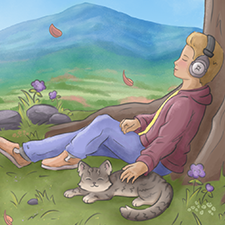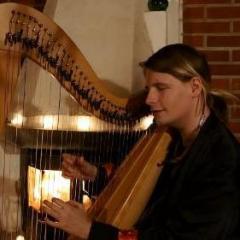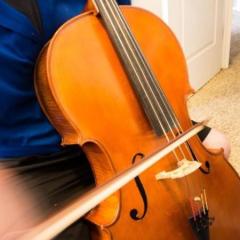-
Posts
4,043 -
Joined
-
Last visited
-
Days Won
24
Profile Information
-
Real Name
Wes M.
-
Location
Mesa, AZ
-
Occupation
Musician
Contact
- Personal Website
Artist Settings
-
Collaboration Status
3. Very Interested
-
Software - Digital Audio Workstation (DAW)
FL Studio
-
Composition & Production Skills
Arrangement & Orchestration
Mixing & Mastering
Synthesis & Sound Design -
Instrumental & Vocal Skills (List)
Piano
Recent Profile Visitors
79,284 profile views
Emunator's Achievements
-
Lovely vibes right off the start, I'm not sure where this is going but there's a tremendous amount of expressiveness in the performances shining through immediately, which persists through the whole arrangement. A really unexpected changeup to the instrumentation hits around the halfway mark, but it's definitely welcomed. Overall, I found that this arrangement passed the bar with no reservations because of the human element added by the live performances - it's expansive enough even though it hews close to the original material, and I don't think there's a strong case to reject this track on arrangement grounds, even though it doesn't deviate from the original structure. Production is more of a mixed bag. Instrument tone is really lovely overall. The mixing is handled in a way that has the piano sounding muffled, like it's coming from the corner of a quiet jazz club, and the guitar taking center stage and covering the lead melody role. I'm not opposed to mixing the piano that way and using it in more of a textural role., but I can see how it might have rubbed the other judges wrong. What's irking me a bit more is the heavy transient emphasis on the guitar - all of the pick noises feel incredibly loud in a way that does break my immersion in the chill vibe. I'm not sure if it's the compression style used or how the instrument was recorded, but it feels like many of the elements have a very plucky transient to it, and that is compounded more in the second half of the instrument when you add more instruments and the panning becomes more chaotic. It also feels like it's picking up on incidental artifacts/noises in the recording itself and accentuating them further - it leads me to suspect that compression might be the culprit here. I'm in agreement with jnWake that the second half of the track is where the production issues feel more present - it's very hard to follow what's going on because of instrument leveling and panning choices that were made - it's a lot to keep track of, and with the transients being so pokey, there's even more competing for my attention. I also felt like the mixing on the piano caused it to get totally lost in this section. I disagree with prophetik that the arrangement is the dealbreaking issue here, but because it's so conservative to the original source and doesn't take as many risks with the arrangement, the production nitpicks weigh a little heavier. That said, I love love love the vibe you've laid out here and the subtle ways you express feeling through your performances. There's absolutely a passing track here and I don't think it'll take much to get it there! NO (resubmit!)
-
 Emunator reacted to a post in a topic:
OCRI-0015 - A Knight (for a Knight)
Emunator reacted to a post in a topic:
OCRI-0015 - A Knight (for a Knight)
-
I was going to get more in-depth on the mix tweaks here but due to issues loading the project file, the best I can do is a remaster on the flattened WAV file to try and introduce some of the bass presence back and narrow the low-frequency stereo width. I do think this sounds a bit better than the first version, so this is good to go! https://drive.google.com/open?id=108LvATvy3BJFjIzDRpJresLZYX28no_B&usp=drive_fs
-
This will be an easy closeout here, since I'm well familiar with it from Dwelling of Duels. I love hearing fresh, modern pop-inspired music on OCReMix - sometimes it feels like pop music and video game music spheres don't have much crossover, so this is a breath of fresh air to hear. Not just conceptually, but from a technical standpoint as well, this is REALLY well executed. The vocal performances and processing techniques feel right up there with modern artists (I can't hear the pitched up vocals without thinking of Porter Robinson, but this technique is happening all over the modern pop landscape) and yet is unlike anything I've ever heard in the VGM scene. You and Chimpazilla synergize beautifully whenever you collaborate, I'm glad you chose to enter this into DoD - it was a well-earned debut placement that really feels like two artists at the top of their game. YES
-

*NO* Legend of Zelda: Ocarina of Time "Domain Deep Dive"
Emunator replied to Liontamer's topic in Judges Decisions
Love this source tune so much, and immediately I felt what you were going for with the genre change - it's a brilliant adaptation. The reharmonization on the backing chords and the keyboard patches chosen for the leads is really working for me on a conceptual level! The harmony and transition just before the 3 minute mark is really cool! I thought we were winding down around the 4 minute mark but then you go into some really cool chord-driven original writing that really captivated my attention. There's a LOT to love about this, just like your other submissions I've voted on recently. I'm immediately hearing the blocky-ness in the arrangement overall, which can contribute to a "plodding" feeling. Obviously, I don't want to imply that you should change the overall groove or pacing of the track itself, but even within a slow-paced arrangement, there's a lot you can do to introduce small amounts of movement to the song so that it's not sitting at the same dynamic level for 5 minutes. To your credit, the jump between the verse and credits is definitely felt, and you've got some unique fills that help build excitement leading into a new section, but the core instrumentation is lacking in variety and humanization, or, if these parts were played live, they're too heavily quantized. I loved the original piano soloing during the 2 minute mark, but those riffs feel like they're programmed or played stiffly as well. I also feel like the velocity on the right hand piano is played too loudly, so the "pluck" of the piano is sticking out in the mix quite a lot. From a mix perspective, there's a good sense of space on the percussion but the kick is lacking any presence in the mix - especially when you have such a solid groove with the kick locked to the 1 and 3, it's important to make sure that the pulse of the track is felt. I think you can also experiment with sidechaining your kick to your bass and other instruments and even your top-loop percussion (I can't believe Chimpazilla, the veritable Queen of Sidechaining, didn't bring this up first! hehe) in order to add some movement to your other instruments when they duck under the kick drum. The electric bass is doing some interesting movements on a writing level, but has almost no presence in the mix. It feels pretty wide and doesn't contribute to a strong foundation. The right hand piano melodies frequently sound much louder than the rest of the instruments, too. The ending snuck up quite suddenly with that final chord, I'm not sure if that ending was properly signaled and so it came across as jarring and unsatisfying to me. I think this is a tremendous first pass at this arrangement and, like your Wild World submission, is 1000% something I want to hear back again. There's a lot of actionable feedback here that I think you could totally execute on your own, but if you're feeling overwhelmed by the feedback here, I will happily extend an offer to collaborate with you on this track if you need help with the mixing to get it over the bar, and also play some of the piano parts live for you. Either way, I dug the track a lot - my door is open if you want to go over this feedback 1:1! NO (please resubmit!) -

OCR04960 - *YES* Chrono Trigger "Howls of the Black Wind"
Emunator replied to prophetik music's topic in Judges Decisions
Whispy Woodwinds hasn't missed to date, and I have no reason to expect this will start now! The arrangement here is fairly straightforward and recognizable, as I would expect, but there's ample personality injected through just the performances alone. This is a solid group, and the addition of prophetik is immediately felt - I recognized that alto tone from the very first note :) Couldn't have thought of a better fit for this group! Lovely arrangement, tons of really smartly arranged interplay between the performers, there's plenty of space for everyone to shine without anybody stealing the limelight, either. My one gripe here, and this may be a stylistic choice to increase the intimacy of the recording more, is that the instrument noises and breaths feel more pronounced in this mix than in previous WW tracks, and I think it might be largely due to the recording placement on the alto sax. Forgive me if I mess up the terminology, but I'm hearing a lot of presence from the fingering/key clicks and IMO this would be stronger with a bit of attenuation to those non-musical noises. A little bit of their presence helps make it feel like you're listening to a live chamber recording, but here, I think it adds some rhythmic mud to the busier parts of the arrangement. Could just be me, I'm not an expert in this genre, so take this for what it's worth! This is an easy pass in my book, all things said! Keep 'em coming, #50 isn't that far off ;) YES -

OCR04923 - *YES* Xenoblade Chronicles "The Road Home" *RESUB*
Emunator replied to Liontamer's topic in Judges Decisions
That snare is loud dude! 😆 I remember this being a "death by a thousand tiny cuts" type of NO vote the last time - it was always a strong arrangement with a great dynamic curve and a spirited performance from TSori, but the programmed elements weren't quite cutting the mustard. I don't remember exactly what the last version sounded like, but literally the only thing that jumps out to me now is the snare - everything else feels like it was ironed out to the point where it's not jumping out to me. On second listen - haha, I felt the exact same thing that Brad noted about 1:42 with the missing transition effect. Good call. I agree that the leads are still lacking the kind of expressiveness I would want to hear - I think studying up on automating expression into your synth leads would do you a lot of good on future tracks, but the sounds are functional and pretty well balanced here so that they don't bring this down too far. The live elements help carry a lot of that weight in this case, but it does naturally draw your attention to the disparity in expressiveness between the different leads. This is definitely above the bar now - not perfect, but that's not what we're looking for regardless! YES -

OCR04904 - *YES* Sky Shark "El Gran Timoteo Cayendo" *RESUB*
Emunator replied to prophetik music's topic in Judges Decisions
Like I've come to expect from tibonev, this is a clean resub that does a diligent job of addressing all the points raised in the first round of voting! I don't have a lot of notes, this tightened up the timing across the board without making the song feel robotic, and makes some subtle tweaks to improve the dynamics across the rest of the track just for good measure :) This is how you do it! YES -
I'm gonna be the naysayer here - I think this is actually pretty on-point for the style. I can definitely see why J's that aren't familiar with vaporwave might struggle with this, but I actually felt like this was better executed than a lot of "mainstream" vaporwave pieces. It definitely scans as a stylistic decision to me rather than an oversight - one of the hallmarks of this genre is really bright, over-the-top reverb washes that blanket pretty much everything, so it sounds like you're listening to it out of a loudspeaker in an old shopping mall. I really dig this a lot, I think this is one of Lucas' best electronic pieces to date. The vocal chops are really tasteful and well-processed, and Sly Man's live performed contributions really make it feel like this track was resampled from an old yacht rock banger from the 70's. I'd encourage anyone on the fence about this to listen through this mix which contains clips of 50 of the most notable vaporwave songs - you'll hear this reverb technique on almost everything: Where I think this song does better than many of the genre mainstays is the presence on the drums/bass - it helps provide a solid foundation in the mix so that it still holds up well compared to more conventionally-produced music, and keeps the washy reverb contained better so that it's still listenable even for those who aren't familiar with this niche genre that's fundamentally supposed to have a lo-fi, low-quality production aesthetic. Not sure if this vote will sway anyone, but I will say this - in my opinion, I think doing anything to change the reverb would fundamentally alter the character of this song and I don't think it would be nearly as memorable if it were produced "traditionally." YMMV, but for me, it's a YES
-
 Thirdkoopa reacted to a post in a topic:
*NO* Sonic Forces "2017 Chill Str."
Thirdkoopa reacted to a post in a topic:
*NO* Sonic Forces "2017 Chill Str."
-
I see I was batsignaled here! I think the other two judges assessment of the track as it stands is right on the money - I see what you were trying to do with the EQ here, but actual lofi production is a lot more nuanced than that. I'm not going to harp too much on that issue, and try to focus my vote on suggestions for tools, resources, and techniques that will help you get closer to your vision. I do want to say that, when comparing this to the source, I like the sounds that you chose and feel like you've got a good ear for sound selection, especially given the high-energy nature of the original track - this approach totally brings something new to the table that, when executed to its full potential, could be really cool! I particularly love the bass sound that seems to have some resonance sweeps going on, it's really unique! So, to recap - conceptually, this is a strong idea and you've got some good building blocks to work off of, but compositionally, it's still structurally too similar to the original track and needs more of your own flair to the arrangement in order to clear OCR's bar. However, the production quality is the main hangup, as there's a few major things that need addressing. I'll bullet point a few primary ones and then share some resources below: Remove the master EQ cuts that you have on your track - I sometimes do apply a very gentle EQ reduction to my lofi tracks to help with tone shaping, but they're usually a high shelf, not a high cut, and I'll apply them much closer to 10kHz and reduce by maybe 3dB - definitely not a full blown cut of almost all of the high frequencies! Instead, I would put EQ/filters on each of your instruments or instrument groups and shape them individually. Play around with using filters that have a resonance built into them too, rather than just a plain EQ cut, which will help character and personality to the track. It will sound much more natural and full if you apply these filters at different frequencies depending on which instrument you're working with. Other ways to achieve that lofi sound is with tape effects like pitch wobble and saturation - lofi production isn't just about cutting out frequencies, but also about doing more to warp/degrade the frequencies that you DO have. You want to make sure that your bass frequencies are still present - right now, there's not much in the way of bass, and the kick drum is much too subdued to fill that role either. This is where comparing with reference tracks will help. The drums and bass feel weak overall, as if you also applied a low cut to the track that removed a lot of the sub frequencies, or just mixed those elements far too quietly. Add textural layers - things like foley sounds, vinyl crackle, or even room noise, when mixed *very* subtly, can give your mix a sense of space. You don't want to overdo it, especially with vinyl crackle samples, but a tasteful dash of it will go a long way. Use reference tracks with a spectrogram plugin. I can't stress this one enough - download some of your favorite lofi tracks and load them up in your project file, then, using a plugin like SPAN, look at how the frequency spectrum is filled up by those tracks and then compare it to your own. You can learn a lot just by comparing your track to a finished track that already sounds good to you. There's a lot of resources you can use to help execute this - there's a few plugins I'll suggest, but I would avoid trying to throw more plugins at your track to fix the problem. The issues I'm hearing stem more from experience and methods rather than not having good enough plugins. Izotope Vinyl - this is an "all-in-one" lofi plugin that you can apply to your master track (again, I STRONGLY recommend not going overboard with this) that can do EQ shaping, tape wobble, and even introduce mechanical noise/hiss/scratches to emulate playing your song off of a record player. It's very easy to overdo it with these sounds, but this is a good starting point to show you how these different techniques will impact your sounds. SPAN - this is a free monitoring plugin that shows a visual representation of how the frequencies in your song are distributed. You can't solely mix with visual cues - eventually, you've got to use your ears - but when you're troubleshooting, this can be a great way to diagnose problems with your mix, and compare them to reference tracks. Lo-fi Reference Tracks - there are a number of songs published on OCReMix that are free to download and use as reference tracks. These have all passed the Judges Panel, so it should give you a good idea of where your track needs to be in order to pass that same bar. OCR Workshop - when in doubt, we have an active Workshop discord that you can use to get additional community feedback or participate in Office Hours events where you can submit your track for realtime critiques from the panel of Sages. I hope this is helpful and you continue to grow your skills and take advantage of the community resources we have available to help you get there :) NO
-

OCR04889 - *YES* Final Fantasy 6 "Dearly Departing"
Emunator replied to Emunator's topic in Judges Decisions
Dead easy vote, Zack is a professional at many crafts, but when I think about the kind of music where he really excels, it's this sort of thing. Multi-instrumental, guitar-driven, orchestrated, lightly-synthetic, brooding... all of these are words I would use to describe what he's created here. Everything is in its right place in terms of frequency balance and stereo separation, making for an incredibly immersive listening experience. I also hear the snare and the drum kit in general cutting through quite a bit more than I would have personally opted for in this style, it sounds like you mixed the drums around the metal section at the end and left the settings intact for the rest of the song. That's about the only gripe I can find after listening to this many, many times. A well-deserved silver medal, sir! YES -
Love the stereo presence and recording quality on this straight off the rip! The faster arpeggios at :12 feel like they're struggling, and the intensity on the backing strums just doesn't really line up. There's a general lack of dynamic management as you go between the more mellow strummed parts to the faster arpeggiated sections. I would love to hear a little more intensity in the backing strums to signal when you're going for a higher energy performance. Oof, yeah, I hear what Brad is saying around 1:27 - the timing is not locked in here :( That unfortunately sounds rough when everything is this exposed, and I do think it's in "dealbreaker" territory. Re-tracking or doing some melodyne to correct timing feels necessary here. The arrangement, while really novel, well-conceived and overall enjoyable, falls short in its execution, and because everything is so exposed, it's even more important that the performance element is completely locked in. With some re-recording or timing corrections in a few key sections you've got a winner! NO (resubmit)
-
I remember feeling like this track was criminally underrated when it debuted in Dwelling of Duels - could be my own personal punk affinity coloring my first impression, but after many repeat listens, although the production critiques came into focus as the rose colored tinting faded slightly, the arrangement and adaptation of the source material is just stellar. I'll stand by that no matter how this vote swings - the lyrics, guitar performance, and overall arrangement quality shine. Listening back with a critical ear, I feel like this track is very transient. There are a few elements here that feel extremely clicky - the pluck on the bass and the ticking clock all feel sharper than than they should. I think some general transient shaping or gentle compression would stop those from peeking out in the mix as much and help you keep everything more balanced. At certain frequencies, you can REALLY hear the pluck on the bass in an unpleasant way - it feels uneven in the mix, and the ticking clock could probably just come down in volume. I didn't notice the mixing on the vocals as much at first, but when I tried to actually pick out the lyrics, it made me realize that I really couldn't tell what the lyrics are simply because they're not cutting through the mix. It's hard to say whether this is caused by improper EQ/compression on the vocals, or if the rest of the instruments are too loud and masking the fundamental frequency of the vocal, or a mix of both. Those are my two main mix gripes. Aside from that, I loved this to death, and I feel pretty strongly that this is enough to pass as-is. I do want to share this mixing critique with you even if the song does pass unconditionally, since I think a few improvements would make it much stronger, but I can't make the argument that this doesn't clear the bar as it stands. Good luck either way! YES
-
I remember liking this one a lot as a causal listener when I checked it out in the workshop forums, so now let's listen with a more critical ear. The vibe is still incredibly strong, capturing the free-spirited feeling of the original but ramping up the playfulness with more chromatic percussion and a more involved backing ensemble. The piano playing and mallets are a highlight here, as well as what you did with the bassline. It adds a lot of interest, and clearly shows that you had some inspiration in the tank when you made this. I am becoming more aware of the shortcomings in the execution here on a repeat listen. The drums, while well-written at the core, are both repetitive and in-your-face. They are mixed pretty loud overall, but also, I'm finding that some of the drum sounds just aren't that well suited for this type of acoustic-driven track. The snare, for example, is quite electronic and snappy, and hits the exact same every time, so it immediately takes me out of the immersion, and the hi-hats feel like they have a similar problem to a degree. I'd explore some other possible sample libraries that are more acoustically-oriented, or at least find some different snare samples that you could alternate between to simulate a round-robin effect, where each hit plays slightly differently. Brad brought up some good points about the room tone and general ambiance of the piece, and the flatness of the piano in the mix. The piano feels dull, even though it's playing a really interesting, colorful part. Compare that to the marimba, which is bright, expressive, and cuts through the mix perfectly as a lead. I would either mix the piano with a brighter tone if you want to go for a more hi-fi sound, or swap the piano sample entirely. Or, alternatively, if you want to go for a different direction or don't have access to better quality samples, you could go the opposite route and intentionally run it through a lo-fi processing chain (Izotope Vinyl is a good free option for this, though RC-20 is the gold standard for lo-fi FX processing if you've got some $$$ to shell out). This is just a stylistic suggestion, but right now, the piano lives in this weird gray area between a high fidelity live recording and a murky, tape-saturated vintage recording style, and it doesn't currently hit either mark well enough to leave an impression. 1:57 is an excellent deviation from the original melody over some lovely chord progressions, and I have to highlight this section because I think it's REALLY well done. That leads me to my last point - the big break at 2:38 had potential, but going right back into the same ground you've already walked, without adding any extra musical ideas or introducing any supporting instruments to give the final chorus a richer presentation, feels like you're demanding the listener's attention and then not capitalizing on it. There's so much room for something new to come up in this final chorus and I think the arrangement needs it in order to justify the structure of the song being presented the way it is. Lastly, you've got way too much of a tail on your fadeout - that should cut off to silence way faster :) I love this track to death but now that I'm holding it under a microscope, I see where it has room to improve. I sincerely hope you take the opportunity to do it! NO (resubmit!)
-

*NO* Final Fantasy Tactics "Cyberpunk Astronomy"
Emunator replied to Liontamer's topic in Judges Decisions
Proph is right - there's a lot of great blocks laid out here - the synth selection, melodies and countermelodies, and overall arrangement are all pretty tightly executed! There is absolutely a passable remix in here, but the production is holding it back. First and foremost, the drums are lacking presence and punch, and thus leave the soundscape feeling underwhelming and lacking dynamics. I would go back to the drawing board on the drum mix to make sure that you've left enough room for your percussion and set the proper volume levels so that everything is audible. My second suggestion is to look at the different instruments in your mix and make sure you don't have any wild frequencies creating spiky resonances, or low-end buildup muddying the soundscape. For example, at 1:40, there's a strong resonance that comes in until about 1:59, and returns throughout the track. I think this might be from the guitar, but something is very obviously peaking above the rest of the instruments and needs to be tamed with some EQ. The other lead synths occasionally have similar issues - this can eat up your space in the mix and generally make it unpleasant to listen to. If you're not already, utilize a free analyzer plugin like SPAN or a paramedtric EQ which can show you where frequencies are peaking. Also check to make sure that your instruments don't have unnecessary frequency buildup in the bass frequencies (below 200hz) since these are going to severely conflict with your kick and bass and make them less distinct. These are the points I would start with to polish the mix, but this is by no means exhaustive. This would be a great candidate to hash out with the community in our Workshop forum or the Discord - we host weekly live WIP reviews on Discord as well that offer an opportunity to get into the weeds on mixing/mastering/production issues like the ones I'm hearing in your song. The good news is that the fundamentals are strong - so keep at it, we'd love to hear this one back! NO (resubmit) -

*NO* Super R-Type "The Bydo Must Fall!"
Emunator replied to prophetik music's topic in Judges Decisions
This is a tough one - I feel like I have a hard time justifying rejecting a really well-arranged, well-produced track such as this one just because the arrangement style doesn't align with the expectations of OCR's catalog. The vote boils down to a philosophical one, not something quantifiable. It should go without saying that I really enjoy this in a bubble, and can easily see why it performed as well as it did in Aliens month! You accomplished the goal of taking a bunch of songs from the Super R Type soundtrack and running through them with a cohesive style and some really competent production chops. That said, I don't think this style of medley is best suited for OCR - again, I want to stress that this is in no way a qualitative judgment on the piece itself, but just a mismatch with the submission standards. The arrangement is extremely linear and the transitions leave this feeling more like a collection of mini-covers that are linked together but don't coalesce into a more fluid, singular arrangement in line with OCR's standards. I also want to cosign Hemo's production feedback - there's a level of muddiness during certain sections that complicates this decision as well. 4:41 brought some drums that sat very strangely in the mix, and might be the only part of the production that I'd say sounded really off to me. The rest (synth leads that didn't quite cut through, slightly muddy low end) were not dealbreakers but things that could be improved marginally in future submissions. I have no doubt you've got stuff in your catalog that would be well suited for OCR, and I do hope that you keep sending stuff our way and this doesn't dissuade you or suggest that we aren't digging your stuff! But I'm not sure that this one is the piece that will get you to the front page. NO









